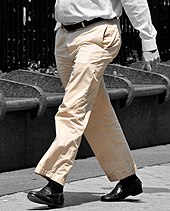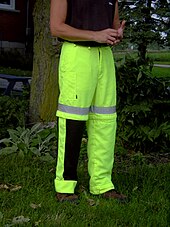Trousers
Trousers (pants in North America) are an item of clothing worn from the waist to the ankles, covering both legs separately (rather than with cloth extending across both legs as in robes, skirts, and dresses).
In the UK, the word "pants" generally means underwear and not trousers.[1] Shorts are similar to trousers, but with legs that come down only to around the area of the knee, higher or lower depending on the style of the garment. To distinguish them from shorts, trousers may be called "long trousers" in certain contexts such as school uniform, where tailored shorts may be called "short trousers", especially in the UK.

In most of the Western world, trousers have been worn since ancient times and throughout the Medieval period, becoming the most common form of lower-body clothing for adult males in the modern world, although shorts are also widely worn, and kilts and other garments may be worn in various regions and cultures. Breeches were worn instead of trousers in early modern Europe by some men in higher classes of society. Since the mid-20th century, trousers have increasingly been worn by women as well. Jeans, made of denim, are a form of trousers for casual wear, now widely worn all over the world by both sexes. Shorts are often preferred in hot weather or for some sports and also often by children and teenagers. Trousers are worn on the hips or waist and may be held up by their own fastenings, a belt or suspenders(braces). Leggings are form-fitting trousers, of a clingy material, often knitted cotton and spandex
History
Prehistory
There is some evidence, from figurative art, of trousers being worn in the Upper Paleolithic, as seen on the figurines found at the Siberian sites of Mal'ta and Buret'.[4] The oldest known trousers are found at the Yanghai cemetery in Turpan,Xinjiang, China, dated to the period between the 13th and the 10th century BC. Made of wool, the trousers had straight legs and wide crotches, and were likely made for horseback riding.[5][6]
Antiquity
A prototype for trousers was first invented by Queen Semiramis in 812 BCE after she led a military expedition against the Medes. The trousers became a fashion trend for while after.[7]
Trousers later enter recorded history in the 6th century BC, with the appearance of horse-riding Eurasian nomads from Central Asia, in Greek ethnography. At this time, Eastern and Central Asian peoples such as the Bactrians,Armenians, Tigraxauda Scythians and Xiongnu Hunnu, are known to have worn them.[8][9]Trousers are believed to have been worn by both sexes among these early users.[10]

The ancient Greeks used the term for the trousers worn by Eastern nations[11] and "σαράβαρα"or the loose trousers worn by the Scythians.[12]However, they did not wear trousers since they thought them ridiculous, using the word of " , "sack", as a slang term for the loose trousers of Persians and other orientals.[15]
Women wearing trousers
Although women had been wearing trousers for outdoor work thousands of years earlier in the Western world, by the time of Christianization it had become taboo for women to wear trousers. It was Eastern culture that inspired French designer Paul Poiret (1879–1944) to be one of the first to design pants for women. In 1913, Poiret created loose-fitting, wide-leg trousers for women called harem pants, which were based on the costumes of the popular opera Sheherazade. Written by Nikolai Rimsky-Korsakov in 1888, Sheherazade was based on a collection of legends from the Middle East called 1001 Arabian Nights.[37]
In the early 20th century women air pilots and other working women often wore trousers. Frequent photographs from the 1930s of actresses Marlene Dietrich and Katharine Hepburn in trousers helped make trousers acceptable for women. During World War II, women working in factories and doing other forms of "men's work" on war service wore trousers when the work demanded it. In the post-war era, trousers became acceptable casual wear for gardening, the beach, and other leisurely pursuits. Further, in Britain during World War II, because of the rationing of clothing, many women took to wearing their husbands' civilian clothes, including their trousers, to work while their husbands were away from home serving in the armed forces. This was partly because they were seen as practical workwear and partly to allow women to keep their clothing allowance for other uses. As this practice of wearing trousers became more widespread and as the men's clothing wore out, replacements were needed. By the summer of 1944, it was reported that sales of women's trousers were five times more than they had been in the previous year.[38]
Parts of trousers
Pleats
Pleats just below the waistband on the front typify many styles of formal and casual trousers, including suit trousers and khakis. There may be one, two, three, or no pleats, which may face either direction. When the pleats open towards the pockets they are called reverse pleats (typical of most trousers today) and when they open toward the fly they are known as forward pleats.

Cuffs
Trouser-makers can finish the legs by hemming the bottom to prevent fraying.[citation needed]Trousers with turn-ups (cuffs in American English), after hemming, are rolled outward and sometimes pressed or stitched into place.
Fly
A fly is a covering over an opening join concealing the mechanism, such as a zipper, velcro or buttons, used to join the opening. In trousers, this is most commonly an opening covering the groin, which makes the pants easier to put on or take off. The opening also allows men to urinate without lowering their trousers.
Trousers have varied historically in whether or not they have a fly. Originally, hose did not cover the area between the legs. This was instead covered by a doublet or by a codpiece. When breeches were worn, during the Regency period for example, they were fall-fronted (or broad fall). Later, after trousers (pantaloons) were invented, the fly-front (split fall) emerged.[57] The panelled front returned as a sporting option, such as in riding breeches, but is now hardly ever used, a fly being by far the most common fastening. Most flies now use a zipper, though button-fly pants continue to be available.

No comments:
Post a Comment